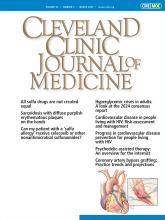To the Editor: I read with great interest the review on insomnia in older adults by Dr. León-Barriera and colleagues1 in the January issue. The authors mention that up to 50% of older adults may have difficulty initiating or maintaining sleep, and that secondary causes of insomnia, such as sleep apnea, should be excluded. One of the important secondary causes of sleep-onset insomnia in adults is restless legs syndrome (RLS). Note that RLS is a misnomer, however, because the disorder can involve the upper extremity; restless limb syndrome is a more appropriate term. The prevalence of RLS increases with advancing age.2 It is a clinical diagnosis made by asking patients if they have a creepy, crawling sensation in the legs or arms with an urge to move; if symptoms occur in the evening or night; if they have onset of symptoms at rest; and if the symptoms improve with movement.
León-Barriera et al1 list mirtazapine, amitriptyline, and the over-the-counter antihistamine diphenhydramine among the agents that have been used for treatment of insomnia. However, these 3 drugs are important secondary causes of RLS, and prescribing them without excluding the diagnosis of RLS has the potential of making sleep-onset insomnia worse.
Recently updated guidelines3 by the American Academy of Sleep Medicine have changed the recommendations for treatment of RLS, now favoring alpha-2-delta ligands like gabapentin and pregabalin as first-line drugs over dopamine agonists.
- Copyright © 2025 The Cleveland Clinic Foundation. All Rights Reserved.






